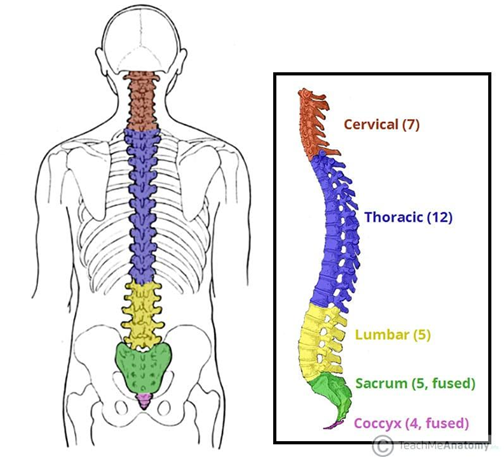Which of the following is the number of vertebrae in each section of the vertebral column?
Cervical: 7: Thoracic: 14: Lumbar: 6
Cervical: 7: Thoracic: 12: Lumber: 5
Cervical: & Thoracic: 12: Lumbar: 5: Sacral 3
Cervical: & Thoracic: 14: Lumbar: sacral: 4
The Correct Answer is B
a: Cervical: 7, Thoracic: 14, Lumbar: 6 - This count for the thoracic vertebrae is incorrect; there are typically 12 thoracic vertebrae.
b. Cervical: 7, Thoracic: 12, Lumbar: 5-The vertebral column consists of cervical (neck), thoracic (upper back), lumbar (lower back), sacral, and coccygeal regions. The cervical region has 7 vertebrae, the thoracic region has 12, and the lumbar region has 5.

c: Cervical: & Thoracic: 12, Lumbar: 5, Sacral: 3 - This count for the cervical vertebrae is incorrect; there are typically 7 cervical vertebrae.
d: Cervical: & Thoracic: 14, Lumbar: Sacral: 4 - The counts for cervical and lumbar vertebrae are incorrect; there are typically 7 cervical vertebrae and 5 lumbar vertebrae.
Nursing Test Bank
Naxlex Comprehensive Predictor Exams
Related Questions
Correct Answer is B
Explanation
a: Electrolytes - Electrolytes are ions such as sodium, potassium, and chloride that play essential roles in various physiological processes but are not directly involved in protecting the body from pathogens.
b. Leukocytes: Leukocytes, also known as white blood cells, are involved in the immune response and protect the body from pathogens such as bacteria, viruses, and fungi.
c: Thrombocytes - Thrombocytes, or platelets, are involved in blood clotting but not in protecting the body from pathogens.
d: Erythrocytes - Erythrocytes, or red blood cells, are primarily involved in transporting oxygen and carbon dioxide and do not play a direct role in immune defense.
Correct Answer is C
Explanation
a. Ovary: The ovary releases the ovum during ovulation, but fertilization does not occur here.
b. Uterus: The fertilized ovum implants and develops in the uterus, but fertilization occurs earlier.
c. Fallopian tube: Fertilization typically occurs in the ampulla of the fallopian tube, where the sperm meets the ovum.
d. Cervix: The cervix is the lower part of the uterus and is not involved in the fertilization process.
Whether you are a student looking to ace your exams or a practicing nurse seeking to enhance your expertise , our nursing education contents will empower you with the confidence and competence to make a difference in the lives of patients and become a respected leader in the healthcare field.
Visit Naxlex, invest in your future and unlock endless possibilities with our unparalleled nursing education contents today
Report Wrong Answer on the Current Question
Do you disagree with the answer? If yes, what is your expected answer? Explain.
Kindly be descriptive with the issue you are facing.
